Anti-ship ballistic missile Khalij Fars (Iran)
In recent decades, Iranian specialists have been actively engaged in the development of rocket weapons of various classes. At the same time, the highest priority is given to ballistic missiles capable of delivering conventional and, in the long run, special warheads to the target. On the basis of the ground-to-ground ballistic missile developments, at some point it was decided to create a new ammunition designed to attack enemy surface ships. The finished product of this type, which became the result of subsequent work, is now known as Khalij Fars.
According to various foreign media reports, the first launches of the Persian Gulf rocket took place back in 2008 during the exercises of the Iranian naval forces. Thus, the development of the rocket began roughly in the first half of the last decade. In February, 2011, the test launch of the rocket, which was first officially announced. Then the representatives of the armed forces of Iran did not disclose the details of the new project, however, they spoke about some of its features. In particular, the main parameters of the rocket and its underlying ideas were announced. Later, according to known data, several more test launches were carried out. In addition, new missiles were repeatedly used during the exercises of the armed forces.
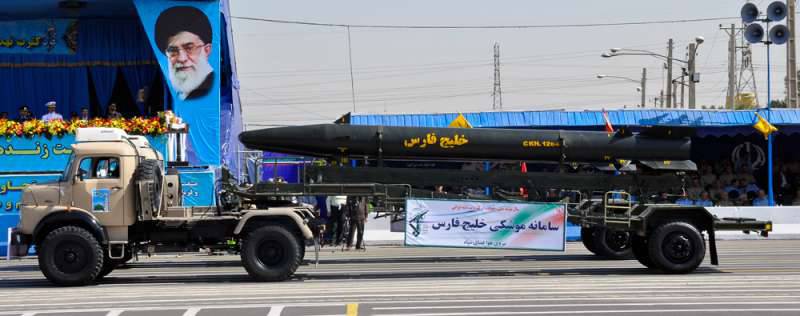
Khalij Fars rocket on a shipping trolley. Parade in Tehran, September 21 2012. Photo by Wikimedia Commons
In 2011, the official representatives of Tehran revealed some features of the Khalij Fars project. It was argued that this ballistic CRP is a further development of the existing Fateh-110 product. This single-stage tactical missile was developed in the nineties and entered service with the 2002. According to some reports, when creating a new rocket, Iranian specialists collaborated with Chinese colleagues. As far as is known, the operation of the Fateh-110 rocket continues to this day. This weapon is in service with Iran, North Korea and Syria. The task of such systems, performed on mobile chassis, is to strike at enemy targets with previously known coordinates.
Apparently, an analysis of the capabilities of the existing rocket technology has shown that the Fateh-110 rocket is the most convenient and advantageous base for a promising means of dealing with enemy ships. This led to the use of a large number of existing units and assemblies, with the help of which a high degree of unification of the new and old missiles was achieved. At the same time, for the new project, several systems had to be developed that were not available on the prototype rocket. The available data suggest that the design work on the Khalij Fars product continued at least until the middle of the two thousandth.
Being a further development of the existing product, the Persian Gulf rocket retains its main features and structural elements. Ballistic CRP has a cylindrical body of large elongation with a conical head fairing. Unlike the base rocket, the new Khalij Fars is not equipped with a pointed fairing. At the head of the case there is a small transparent part of a hemispherical shape used by the optical system of the homing head. Immediately behind the fairing are placed triangular steering wheels of the X-shaped design. In the rear part of the body two sets of planes of similar structure are mounted: these are triangular and trapezoidal stabilizers.
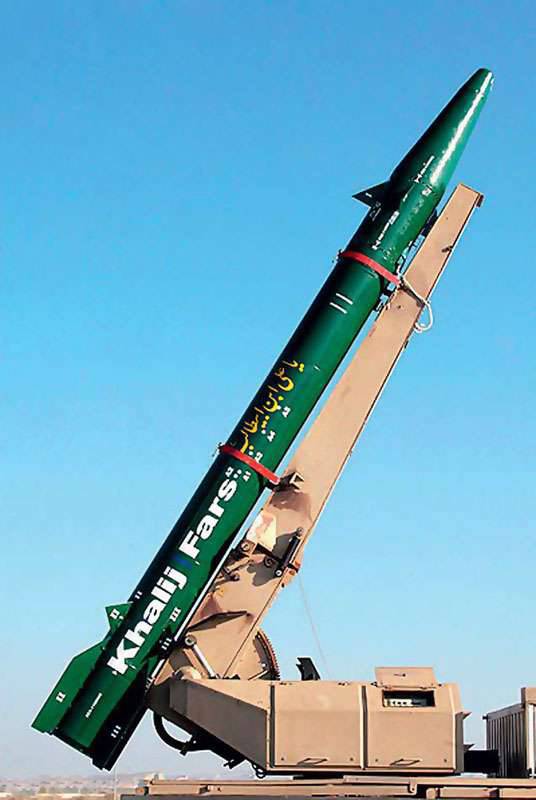
Launch the launcher. Photos Otvaga2004.ru
The total length of the anti-ship missile is 8,86 m, the case diameter is 0,6 m. The rocket is built in a one-step scheme and does not have the ability to divide into blocks, including dropping the warhead. This allowed us to simplify the design, although it imposed certain restrictions on the characteristics. From the point of view of the main flight parameters, Khalij Fars is not very different from the base Fateh-110.
Khalij Fars single-stage rocket retains the powerplant of the base product. It is equipped with a solid-fuel engine that provides acceleration to the required speed and output to the desired path. Engine power and fuel is enough for a flight over a range of 300 km. By correcting the trajectory in the initial part of the flight, the rocket is capable of changing the firing range within fairly wide limits.
The Fateh-110 ballistic ground-to-ground missile is equipped with an inertial guidance system, ensuring the destruction of fixed targets with previously known coordinates. For anti-ship weapons required a new guidance system that can independently perform the detection of mobile surface objects. As follows from the available data, the Khalij Fars rocket received a combined guidance system based on inertial navigation equipment and a thermal homing head. Thus, in the initial part of the trajectory, before going into an uncontrolled flight, the inertial system should be controlled, and the infrared homing system turns on after reaching the target area when the rocket falls down. Flight control on the final leg should be carried out using the available rudders.
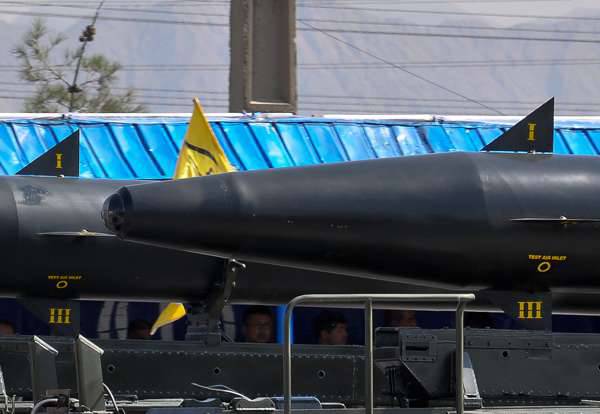
The head fairing of the rocket, is clearly visible transparent cover GOS. Photo of Wikimedia Commons
Nevertheless, some sources claim that the rocket received not a thermal, but a television homing head with the ability to transmit a video signal to the console of the missile complex operator. Both versions may find evidence of one kind or another. In particular, the characteristic appearance of the target ships used during the tests and exercises, as well as some shots from the video published by the Iranian military, can speak in favor of the version about the television seeker.
Thus, the Iranian engineers were able to successfully solve one of the most difficult tasks in the development of ballistic missiles - the search for a mobile surface target, followed by pointing at it. Targeting for the complex is proposed to carry out using radar and other means of detection. According to their data, the missile system must calculate the flight program for the active part of the flight, with the help of which the missile, after moving to the downward part of the trajectory, should go to the target area. Detection and tracking of the target with the subsequent guidance of the rocket is proposed to carry out an infrared or television GOS.
According to statements by Iranian officials, during the first tests held in 2011, the Khalij Fars homing head hit a moving surface target with a deviation of 30 m. After that, the customer, in the person of the armed forces command, was tasked to double the accuracy of shooting. After finishing the product and improving the guidance system, the next tests ended with the defeat of the target with a deviation of 8,5 from the aiming point. As a result of the necessary improvements, the rocket was able to effectively attack enemy ships. It is noteworthy that only two months passed between two test runs with radically different accuracy indicators.
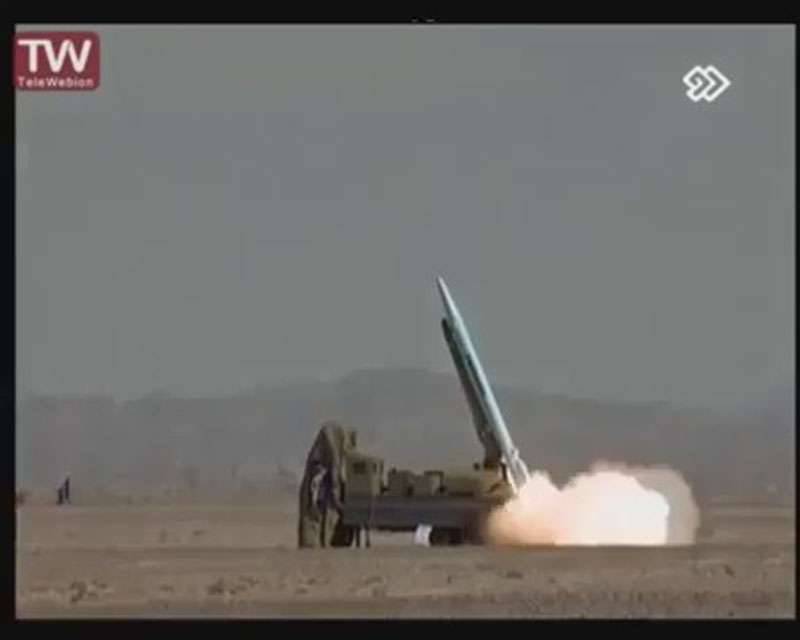
The launch of the Persian Gulf rocket. Shot from the TV report
To destroy the target, the Persian Gulf rocket is equipped with a high-explosive warhead weighing 650 kg. When falling on a target at high speed, such a warhead may work as penetrating, exploding after breaking through the deck or other elements of the ship. When undermining the inside of the target ship, the disabling of various systems or its flooding is guaranteed, depending on various factors. Ships of relatively small displacement with defeat 650-kg warhead guaranteed to be destroyed, larger targets should receive serious damage, making it impossible to continue full combat work.
To launch Khalij Fars missiles, it is proposed to use a mobile launcher based on a semi-trailer. An appropriate type of tractor should tow the platform with a special turntable that carries the guide for the rocket. As can be seen on the published videos, before launching, a semi-trailer with a rocket must be mounted on supports, and the tractor is taken to a safe place. Before launching the rocket rises to the desired angle of elevation, after which the engine is turned on and it comes off the guide. For transportation of missiles and reloading on launchers, a towed semi-trailer with the necessary attachments is used. Like many other Iranian-developed missiles, the Persian Gulf is transported and launched without the use of transport-launch containers. To protect the products used only fabric covers, etc. equipment.
According to some reports, the Khalij Fars missile tests began at the end of the last decade. However, accurate data on this score is missing. The first test launch of the new RCC was announced only in February 2011 of the year. An experienced rocket was launched from one of the coastal test sites in Iranian territory. As a learning target, a decommissioned vessel, tanker, or dry cargo ship was used. To assess the accuracy of the hit (or to simplify the work of the homing head) special shields were installed on the deck of the target ship. As representatives of the Iranian armed forces reported, during the first launch, the prototype of the rocket showed accuracy at the 30 m level. After the first launch, the work on the rocket continued. Now their goal was to improve onboard systems.
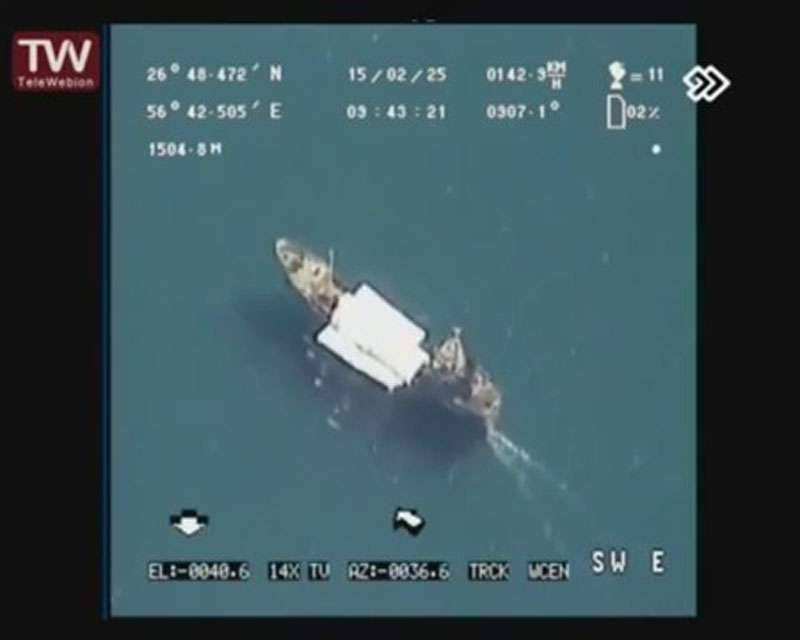
The target used in the tests, shooting from the air. Shot from the TV report
After about six months, i.e. In the summer of 2011, another launch took place. By this time, the authors of the project received an order to double the accuracy. The task was successfully solved: instead of the required 10-15 meters of deviation from the aiming point, the experienced Khalij Fars rocket showed accuracy at the level of 8,5 m. There is also information about another test launch in the middle of 2012. Probably, there were other test launches, but information about them was never able to penetrate the media.
Already in 2011, it was claimed that the Persian Gulf ballistic missile would be in mass production in the near future. Apparently, these plans were soon realized, with the result that the troops began to receive and develop new weapons. Already in 2012, the new rocket was first shown to the public. In September, a military parade was held, during which various weapons and military equipment were shown, including tractors with transport trucks and Khalij Fars missiles.
Available information suggests that the Khalij Fars missiles have already been adopted by Iran and have become the standard weapons of some units responsible for the defense of the coast. Thus, the Iranian armed forces already have quite interesting and promising weapons. Known data on new type missiles may reveal some features of their potential in terms of combat use.
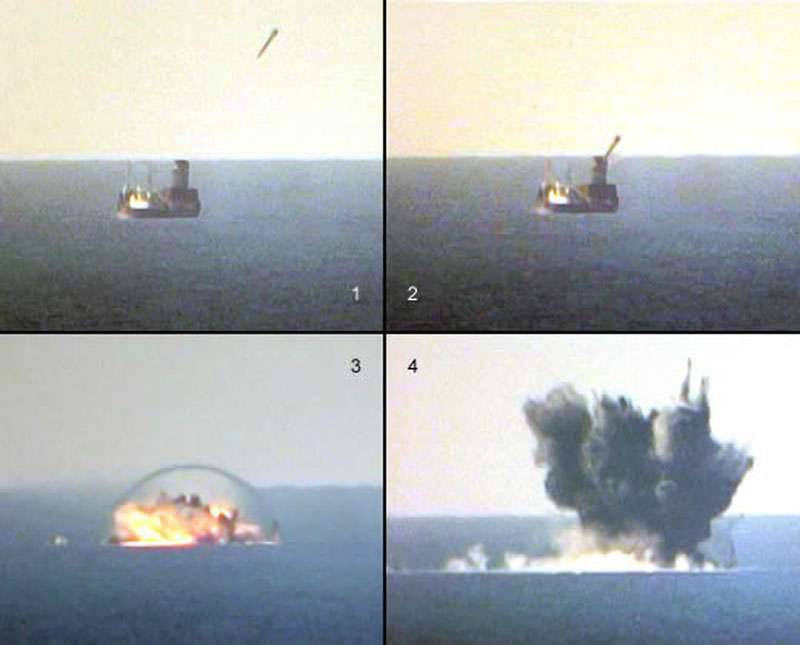
The defeat of the educational purpose. Photo Defense-update.com
Probably, the new anti-ship missile is not just called the "Persian Gulf". With a firing range of up to 300 km, this product launched from a particular section of the Iranian coast can hit targets in almost the entire area of the Persian Gulf, including the remote shores of the Arabian Peninsula. The zone of responsibility of such missiles may also include the Gulf of Oman (in full) and a large area in the north of the Arabian Sea. Thus, in theory, the Khalij Fars missiles are able to protect Iran from sea threats from any dangerous directions: all the nearby seas and bays, at least partially, are in the zone of action of such missiles.
The potential of the Khalij Fars rocket in a real battle against the conditional enemy ships can be a subject of controversy. On the one hand, such weapons really represent a great danger from ships, but on the other hand, developed countries already have in service anti-aircraft systems capable of fighting with ballistic missiles of this class. Thus, the actual result of the use of the Persian Gulf missiles in the course of an armed conflict may differ significantly from the expected one. It is clear that it will depend on the mass of various factors, and for this reason the correct prediction of the results of the application is very difficult, if at all possible, to do.
Nevertheless, even with a completely unclear potential of a new type of rocket, it is fully capable of solving the tasks of deterring a potential enemy. Iran has strained relations with several neighboring Middle Eastern states, and this tension may sooner or later lead to armed conflict. However, in the event of an attack on Iran, the enemy country risks getting hit by naval ships closer than 300 km from the Iranian coast. The map of the region clearly shows that if Iran has similar missiles, the enemy’s naval forces either completely withdrawn from the war or lose the ability to work and attack the Iranian coast.
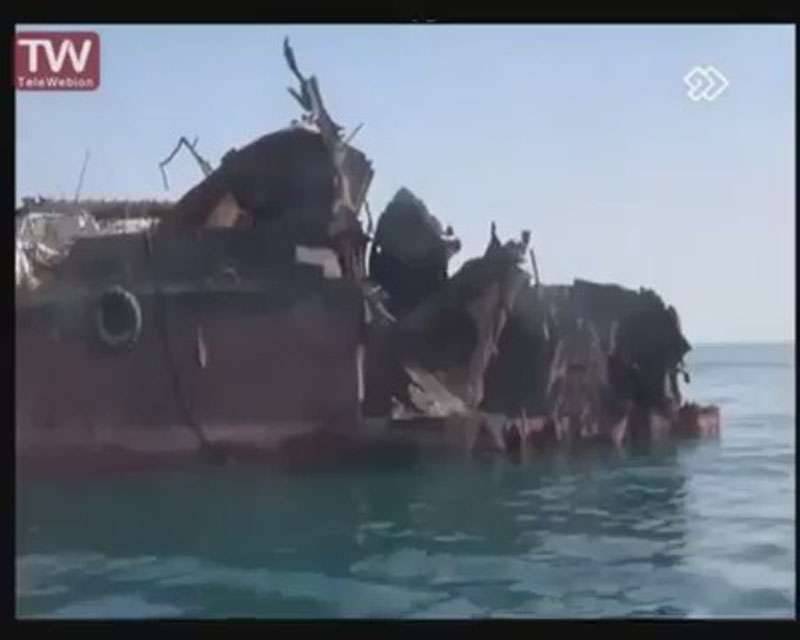
Target ship after hitting the Khalij Fars rocket. Shot from the TV report
Significant risk of losing ships can be a good deterrent to warning the attack of unfriendly states. As for the ambiguity and the controversial potential of Khalij Fars missiles, it can only be determined in the course of a real war. But such methods of identifying enemy capabilities are simply unacceptable and are unlikely to be used by the likely adversary. Thus, military analysts of the Middle Eastern states can only study the issue and build predictions of different plausibility.
It should be recalled that currently only two anti-ship ballistic missiles are in service in the world. These are Chinese DF-21D and Iranian Khalij Fars. These two products have a lot of differences, both in the basic characteristics and in the principles of work. However, they are designed to solve the same problem. Their goal is to deter naval forces of a potential enemy or, in the event of a conflict, attack enemy ship formations with the destruction of ships at long range from the coast.
Ballistic anti-ship missiles are currently an uncharacteristic way of dealing with enemy ships. Nevertheless, judging by the appearance of new projects in recent years, such weapons are of particular interest and are ordered by the armed forces of individual countries. Other states, however, prefer to rely on the more familiar "traditional" cruise missiles. Perhaps in the future, the list of ballistic missiles adopted for service will be supplemented with new products, but at the moment this class of missile systems is represented by only two samples. Reliable information on the creation of new weapons of this class is not yet available.
On the materials of the sites:
http://defense-update.com/
http://armyrecognition.com/
http://otvaga2004.ru/
http://thediplomat.com/
http://globalsecurity.org/
Information